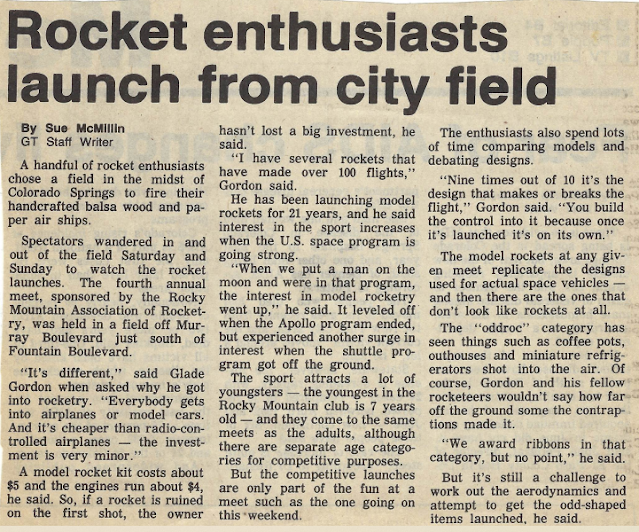The Rocky Mountain Association of Rocketry, NAR Section #331, ceased to exist sometime in early 1984.
The odd thing is that the club was going along very well through 1983. Membership numbers were good, we were enjoying a healthy news letter exchange with a number of other sections around the country, meets and contest events were well attended.
Additionally, we were paid a surprise visit by NAR president J. Pat Miller in late 1982. He happened to be in Colorado Springs for business the same time we held one of our club meetings. I recall that there was serious discussion at that meeting about ROMAR hosting NARAM 26 in 1984! Throughout 1983 this topic was uppermost in a lot of club member's minds
Then - poof! - it all just fell apart.
I can take partial credit for this, as my wife and I had just started a family, and my place of employment was booming at the time. Overtime work was abundant and often mandatory. I had to make drastic reductions in my involvement in the model rocket hobby, with club activity participation taking the most serious hit.
In addition, fellow ROMAR charter member, Glade Gordon, had recently taken a new job in the small Colorado Mountain town of Buena Vista, so he could attend only the largest of club events.
Brian Fox and his father George dropped out of sight because Brian had graduated high school and was ready to pursue college. I believe there were one or two other Leader club members that were in the same situation.
A recent, but very supportive member , Larry Quam, left Colorado to take another job.
Essentially, all of our key members - the folks who were instrumental in getting things organized and done - left town or became otherwise unavailable.
ROMAR had enjoyed a great eleven year run before we had to finally knock it on the head.
On a more personal note, the end of ROMAR was a major catalyst in my quitting the hobby in 1984 and selling off the bulk of my rocket stuff in 1985.
This is a picture of my last 'old fleet' model rocket, a futuristic design that I never gave a name. This model, fleet #103, flew one time, most likely at the very last sport launch conducted by ROMAR sometime in late 1983. I have no date or documentation on the flight.
The next model rocket I would build would have to wait for 32 years when I BAR'd in May 2016.
One final, and somewhat sad note in all of this is the announcement for HOTROC-5 published in what became the final issue of The Cosmic Steppingstone:
HOTROC-5 never happened.....
































